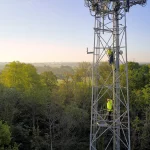New Ofcom Rule on Misleading “Fibre” Terminology Puts Spotlight on Ads Watchdog

The UK Advertising Standards Authority (ASA) has told ISPreview that they’re “keeping a watching brief” on how Ofcom’s recent move to clampdown on confusing uses of “fibre” terminology (here) may impact their own guidance on advertising claims. But at present, the ASA and Ofcom’s position still appear to be in some conflict.
In case anybody overlooked Monday’s developments, Ofcom began enforcing new rules that only allowed broadband ISPs to use terms like “fibre” and “full-fibre” on their websites, and in contracts, if their network brings the fibre optic cables all the way to your home (i.e. FTTP, FTTH and also FTTB). The goal was to clear up some historic confusion between slower hybrid / part fibre (e.g. FTTC) and faster full fibre (FTTP/H) lines.
“From today, broadband providers will need to be clear and unambiguous about whether the network they use is a new ‘full-fibre’ network – with fibre all the way to a customer’s home – or a ‘part-fibre’, ‘copper’, or ‘cable’ network. Providers will no longer be able to use the term ‘fibre’ on its own,” said Ofcom.
Advertisement
However, the regulator’s rules were somewhat restricted, not least because they only focused upon information or descriptions offered “at point of sale on the website, and before the final purchase in contract information, and in the contract summary” (i.e. it doesn’t cover websites in their entirety). Ofcom also went a bit further by stating that the use of the word “fibre” on its own for describing the underlying technology is “ambiguous, and therefore should not be used to describe the underlying technology“.
The difficulty is that the regulator’s rules did not extend to ADVERTISING, which creates somewhat of a conflict with the historically indifferent approach of the Advertising Standards Authority. The ASA has often rebuffed attempts to ensure clearer uses of terminology in these areas (here and here), which over the years did cause some comical advertising (see article picture). This is also one of the reasons why BT, in its response to Ofcom’s original consultation on the change, similarly argued for the regulator to make clear that advertising would not be impacted (here).
Extract from BT’s Consultation Statement
Whilst we understand that Ofcom’s assessment is based on how to give customers more information to ensure they are making the right purchase decision, there is an inconsistency with the ASA’s approach to the term ‘fibre’. We would like Ofcom to make it clear that their position has no reflection on the ASA’s established position that using the term ‘fibre’ to describe FTTC in advertising is not misleading.”
However, most of the responses to Ofcom’s original consultation did agree that the advertising watchdog’s policy would ideally need to be updated in order to avoid inconsistencies. This is in fact something that the ASA itself similarly acknowledged may need to be re-examined.
Extract from the ASA’s Consultation Statement
“At the conclusion of Ofcom’s work we will, as an evidence-led regulator, consider any evidence provided by contributors if it has a bearing on our position. Assessing what impact any new standards have on wider advertising practices around fibre, we will evaluate whether the time is right to review our 2017 decision again in the light of more recent developments and any related new compelling evidence.”
The introduction of Ofcom’s new rules thus presents another opportunity for the ASA to conduct such a review, which is something that ISPreview asked them about again on Monday. A spokesperson for the ASA noted that Ofcom’s review “never tested for ‘misleadingness’” and reiterated that they are “keeping a watching brief on if/how the guidance impacts on advertising claims.”
Advertisement
The ASA’s “watching brief” includes responding to complaints and consumer concerns in this area, while at the same time keeping “under review” if or how their own guidance might need to “evolve to reflect any changes in consumer understanding/expectations around fibre broadband.”
At this point it’s worth noting that the ASA has, over the past year, clamped down on a number of adverts that strayed into a similar field. For example, they stopped broadband ISP 6G Internet (IX Wireless) from creating some confusion with the future 6G mobile standard (here) – 6Gi are separately now rebranding to Opus Broadband – and later slapped the same provider for promoting their wireless service as “full fibre” (here).
Granted, the above example is arguably from the extreme end of the debate, although it does indicate that the ASA is capable of recognising why such confusions may need to be addressed. But only time will tell whether they’re willing to align more closely with Ofcom’s new position.
Back in 2018 the ASA claimed, based on its own consumer surveys, that “fibre” wasn’t a priority identified by consumers when choosing a package; that consumers did not notice “fibre” claims in ads and that they saw it as a shorthand buzzword to describe modern fast broadband. Respondents told the ASA that they did not believe they would change their previous decisions, even after the differences between those and broadband services that use fibre optic cables all the way to the home were explained to them.
Advertisement
Mark is a professional technology writer, IT consultant and computer engineer from Dorset (England), he also founded ISPreview in 1999 and enjoys analysing the latest telecoms and broadband developments. Find me on X (Twitter), Mastodon, Facebook, BlueSky, Threads.net and Linkedin.
« Frustration in Rural Wales as Village Suffers Poor Voneus Connectivity






















































Presumably these new rules don’t care about differentiating the different forms of fibre? For example, RFoG being DOCSIS over a different physical layer. The point I’m trying to make is that “fibre”, even when it is delivered over actual fibre, can be very different from one another.
I guess docsis is still fibre to the home (but not fibre to the router)
Correct, and rightly.
It’d get a little excessive having GPON, XGSPON, 25GPON/25GSPON, RFoG, 1GBase-BX and 10GBase-BX for the types of connections going into premises over a single fibre right now if the regulations required the operators to state how a full fibre service is delivered.
Fibre is like a pipe, it’s just a dumb carrier. In the case FTTP it means fibre to the ONT, and it doesn’t matter whether it’s carrying DOCSIS frames (for RFoG) or GEM frames (for xPON). And what cable is used from ONT to router is irrelevant for the purpose of defining FTTP.
The most important paragraph in this whole piece is the last one.
Doing an availability check today, BT is still calling VDSL “Fibre 1” and “Fibre Essential”, so clearly the OFCOM ruling is being blatantly ignored.
But they have that tiny text at the top of the page “All plans shown use part fibre technology” so how could there be any room for confusion that the “Fibre” plan isn’t actually full fibre?!
Thinking I might start selling “British mince” down at the local farmers market, as long as I have a tiny sign up saying “All mince shown uses part British mince” I should be fine to mix 90% imported meat with 10% British meat but call it British mince right?
Not to forget the misleading “Fibre 2” VDSL package.
Another clear case of how the ASA has been a complete failure, and Ofcom not yet acting either.
They’re probably obeying the Ofcom rules in word if not in spirit. Up to the ASA to step in now. There’s nothing in the new rules on what an ISP can name a product only requirements on the information they have to give.
https://www.ofcom.org.uk/phones-and-broadband/bills-and-charges/customers-to-get-clearer-broadband-information/
It wasn’t an advertisement: it was the actual product name on their signup page.
If BT are still allowed to call the VDSL products “Fibre 1/2/Essential” (as opposed to “Full Fibre” for the FTTP products) then nothing has changed as a result of the OFCOM ruling.
I guess rfog is still fibre to the home (but not fibre to the router)
Sometimes I do wonder if Ofcom is deliberately inadequate due to regulatory capture, otherwise how does it take to 2024, to come to this decision?
This isn’t a very good argument for the mission purpose and effectiveness of either Ofcom or the ASA. It sounds as though lots of people, who are undoubtedly highly paid, have had meetings and created documents. They have themselves acknowledged both the inconsistencies and inadequacy of the literature. The result? A fat lot of expensive nothingness.
It’s like a lesson in how not to run a project. Be expensive. Fail to reach consensus. Take a long time deciding to arrive at inconclusive. About a subject you’re not going to enforce and which nobody cares about.
Today EE (the retail arm of BT for broadband and mobile) who provide my mobile phone service texted me to say I could switch to their Fibre “50 product” with 3 months free and increase my existing mobile data allowance (10Gb). Surely, this is now ILLEGAL?
Just to be clear our consumer championing regulator concluded that becuase some operators felt it would cost too much to change their product names that:
5.18 We have concluded that the most important aspect of our proposals is that consumers are
informed about the underlying technology of the services available to them so that they can
choose the broadband service that is right for them. In our judgement, this is more
important than reserving the use of the words ‘fibre’ and ‘full-fibre’ for FTTP more generally
and is sufficient to meet our policy objective. We have therefore removed this aspect of our
proposals from our new guidance. Providers will remain free to use the term ‘fibre’ in their
product names (subject to other rules and guidance that may apply e.g. in the context of
advertising).